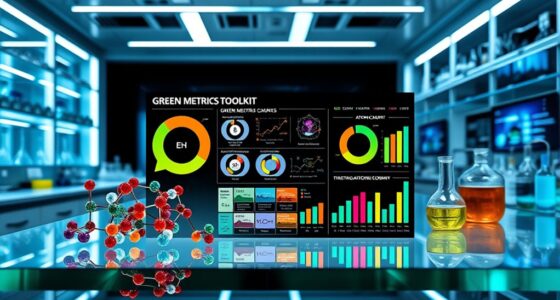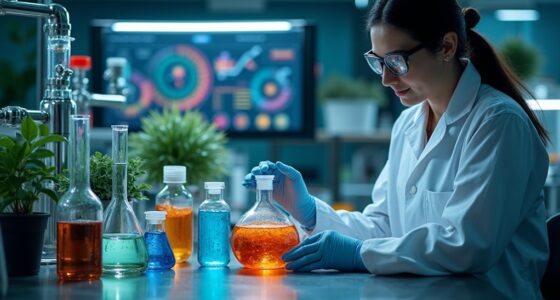Biodegradable plastics are promoted as eco-friendly, but their real impact varies. They require specific conditions like heat, moisture, and microbes to break down completely, which aren’t always available in real environments like landfills. Some degrade into microplastics or release harmful substances if not disposed of properly. To truly benefit, you need to understand their limitations, standards, and proper disposal methods—stay with us to explore the truth behind biodegradable plastics.
Key Takeaways
- Not all biodegradable plastics fully decompose in natural environments; proper industrial composting conditions are often required.
- Some biodegradable plastics can generate microplastics or release harmful substances if degradation is incomplete.
- Biodegradable plastics are sometimes marketed as eco-friendly without clarifying their actual environmental impact or disposal requirements.
- Their degradation rate varies based on environmental factors like temperature, humidity, and microbial activity, making cleanup unpredictable.
- Certifications and standards help verify biodegradability claims, but consumers should recognize that these plastics are not a universal solution to plastic pollution.
Understanding What Biodegradable Plastics Are
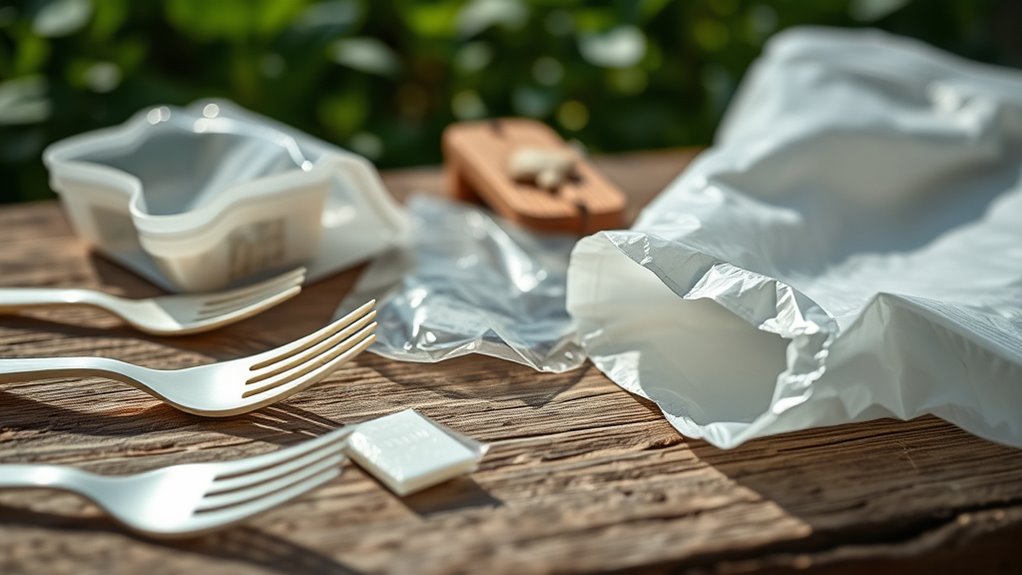
Biodegradable plastics are materials that microorganisms can break down into water, carbon dioxide, and biomass under specific conditions. These plastics include bioplastics from renewable sources like corn starch or sugarcane, and plastics made from petrochemicals with biodegradable additives. Not all biodegradable plastics are necessarily biobased; some are entirely petroleum-derived but contain additives that enable biodegradation. Keep in mind, not all bioplastics are biodegradable; the terms aren’t interchangeable. Scientifically, biodegradable plastics undergo accelerated degradation by organisms and enzymes, forming small, metabolizable molecules. Understanding biodegradation processes is crucial for assessing environmental impacts and proper disposal methods. To help consumers identify them, standards and labels like the compostable logo are used. These plastics are versatile, produced through various methods such as extrusion or injection molding. They find applications in organic waste bags, agriculture, food packaging, and disposable tableware, making them a popular eco-friendly alternative to conventional plastics.
How Do Biodegradable Plastics Break Down?

Once environmental conditions align, the breakdown process for biodegradable plastics begins with physical and chemical disruptions that make them accessible to microbes. Sunlight’s UV radiation damages the plastic surface, creating entry points for microbes. Warmer temperatures boost enzyme activity, speeding up degradation, while humidity supports microbial growth and enzymatic action. Physical forces like abrasion fragment the plastic, increasing surface area for microbial attack. Environmental factors significantly influence biodegradation rates, making optimal conditions crucial for efficient decomposition.
Microorganisms then secrete specific enzymes that target chemical bonds in the polymers, breaking long chains into smaller molecules like oligomers and monomers. These smaller molecules are absorbed by microbes as energy sources.
Under suitable conditions, enzymes work under both oxygen-rich and oxygen-deprived environments, converting plastics into harmless byproducts like CO₂, water, and biomass, completing the biodegradation process.
Practical Uses and Environmental Impact
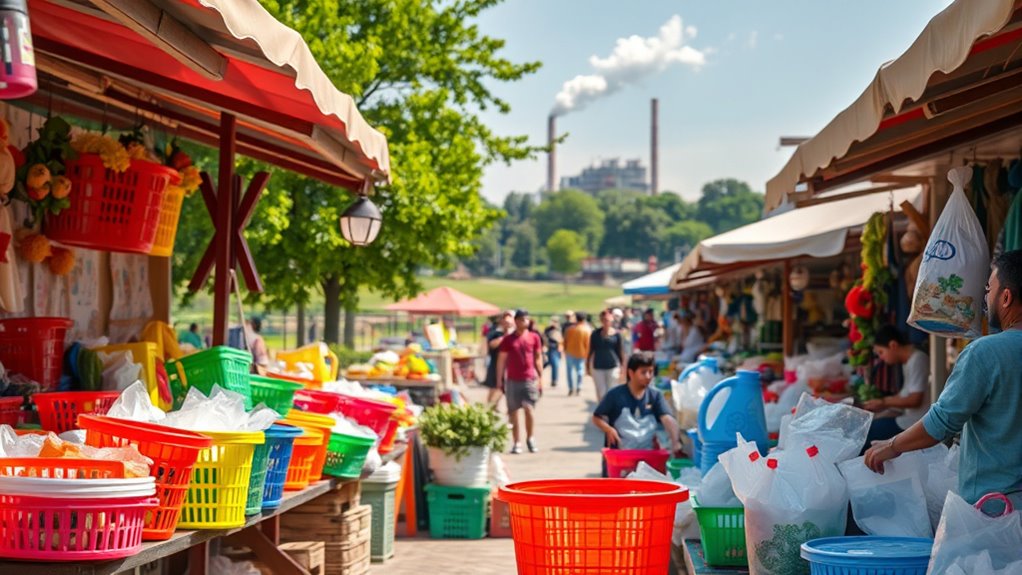
Practical applications of biodegradable plastics are expanding across various industries due to their eco-friendly benefits. You’ll find them in food packaging, helping reduce reliance on traditional plastics and lowering waste in landfills. In agriculture, biodegradable mulch films and plant pots enrich soil health by decomposing naturally, cutting down on waste and erosion. Disposable tableware made from bioplastics offers a sustainable alternative for restaurants and events. Cosmetic packaging, like cream jars and lipstick containers, also benefits from biodegradable materials. Additionally, plant pots that can be directly planted into the ground eliminate waste associated with removal. Biodegradable plastics can be foamed, extruded, or injection-moulded using modified conventional machines, making them versatile for various manufacturing processes. Environmentally, these plastics help conserve soil, decrease plastic waste, and support composting efforts. Proper disposal methods and understanding biodegradation processes are crucial to ensure these plastics break down effectively and do not contribute to microplastic pollution. While concerns about microplastics exist, proper biodegradation reduces harmful residues, making these materials a promising eco-conscious solution.
The Benefits and Drawbacks of Biodegradable Alternatives

As industries adopt biodegradable plastics to address environmental concerns, it’s important to weigh their advantages against potential limitations. These plastics reduce fossil fuel reliance, need less energy to produce, and decompose faster under ideal conditions. They also have the potential to leave no pollutants and lower your carbon footprint. However, drawbacks include incomplete breakdown, which can create microplastics, and the release of harmful substances like metals and methane. Plus, a single-use mindset may persist, and higher production costs limit accessibility. Additionally, biodegradable plastics require specific composting conditions and infrastructure. To understand their real impact, consider this comparison:
| Benefit | Drawback |
|---|---|
| Reduces fossil fuel use | Incomplete breakdown risk |
| Lower energy use | Can release harmful substances |
| Faster decomposition | Requires special conditions |
| Potential to leave no pollutants | Higher production costs |
| Smaller carbon footprint | Limited recycling options |
Myths and Misconceptions About Biodegradable Plastics
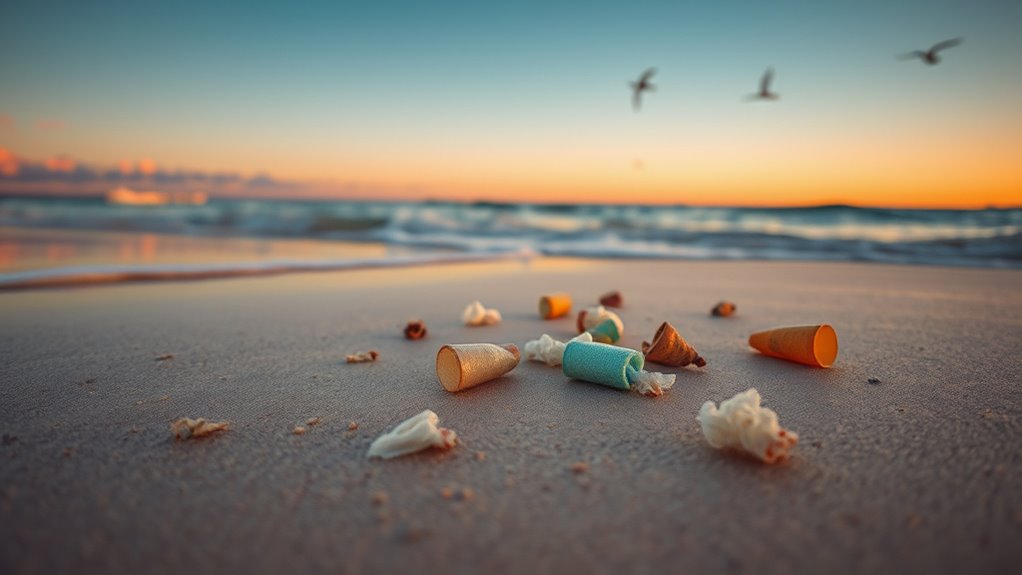
Many people believe that biodegradable plastics instantly dissolve after disposal, but this is a misconception. In reality, they need specific conditions like heat, moisture, and microbes to break down effectively. Biodegradation depends on environmental conditions, which vary widely. Biodegradable plastics aren’t always compostable; composting requires industrial facilities with controlled environments, which many biodegradable plastics need for full decomposition. They can be as durable as traditional plastics and are used in packaging and durable goods. It’s also a myth that biodegradable plastics are inherently more environmentally friendly—if not managed properly, they can contribute to pollution. Some biodegradable plastics, especially those treated with eco-friendly additives, help reduce microplastic formation by promoting microbial digestion. Additionally, the actual degradation rate can be influenced by the composition of the plastic, which varies significantly among different formulations.
Making Informed Choices: Standards and Labels
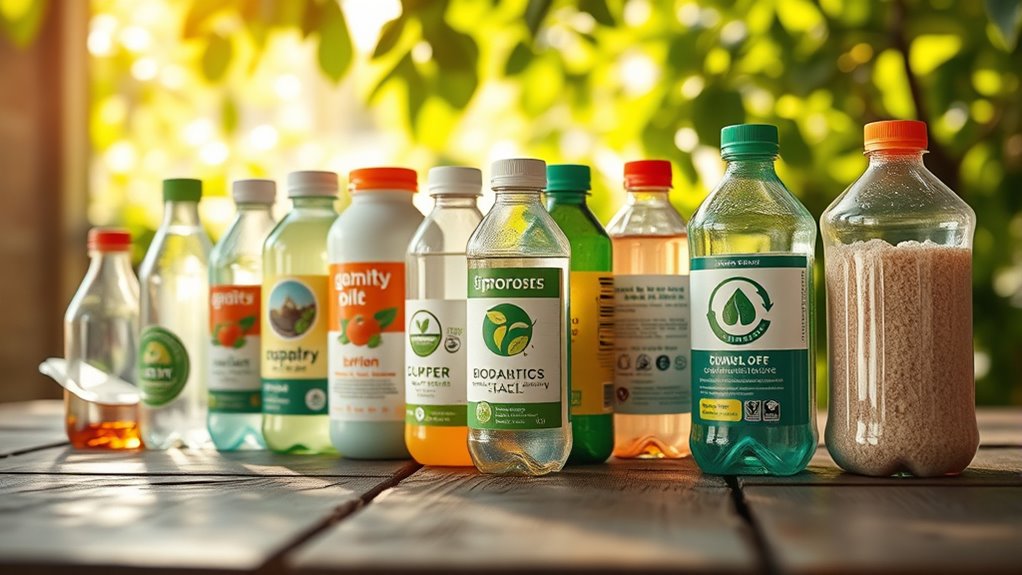
Understanding the standards and labels associated with biodegradable plastics helps you make informed decisions about their environmental impact. International standards like EN 13432, ASTM D6400, and AS 4736 set clear criteria for biodegradability and compostability, specifying conditions and timeframes to ensure reliable claims. Certification labels such as BPI Certified Compostable, Seedling Logo, and OK Compost indicate products meet these standards, giving you confidence they’ll break down safely in industrial facilities. Labels also clarify whether a product is suitable for industrial or home composting, preventing confusion. Third-party certification ensures impartial verification of compliance, increasing consumer trust. Measuring biobased content through standards like EN 16640 and ASTM D6866 helps identify renewable materials used, separate from biodegradability. Clear, third-party certification and transparent labeling enable you to choose environmentally responsible plastics and support better waste management.
Frequently Asked Questions
Can Biodegradable Plastics Be Recycled Like Conventional Plastics?
You might wonder if biodegradable plastics can be recycled like conventional ones. The answer is yes, but with conditions. Some biodegradable plastics can undergo mechanical or chemical recycling, similar to traditional plastics.
However, they often require specialized facilities and proper separation from other waste. To maximize recycling, you’ll need to follow specific disposal guidelines and support infrastructure development, ensuring these materials contribute positively to sustainability efforts.
Are All Biodegradable Plastics Suitable for Marine Environments?
Like a fragile leaf in the wind, not all biodegradable plastics are suited for marine environments. You need to understand that their degradation rates vary depending on chemical makeup and habitat conditions.
Many plastics break down slowly or partially, leaving microplastics behind. So, you can’t assume universal suitability.
Responsible use, proper disposal, and awareness are vital because environmental factors heavily influence whether biodegradable plastics genuinely help or harm marine ecosystems.
How Does Temperature Affect the Biodegradation Process?
You might wonder how temperature impacts biodegradation. Higher temperatures speed up microbial activity, doubling degradation rates every 10°C, especially for bioplastics. It’s like hitting the gas pedal—more heat means faster breakdown.
However, be aware that increased temperatures can also produce more microplastics and toxicity. By controlling temperature, you can optimize biodegradation but must balance environmental and economic factors for effective results.
What Is the Actual Environmental Impact of Producing Biodegradable Plastics?
Think of biodegradable plastics as a double-edged sword. You might see them as eco-friendly, but their production still relies heavily on fossil fuels, contributing to climate change and pollution.
You need to contemplate the water and energy used, along with land impacts from crop cultivation. While they emit fewer greenhouse gases, their environmental benefits depend on sustainable practices, and mismanagement can still lead to pollution and habitat loss.
Do Biodegradable Plastics Release Microplastics During Degradation?
You might wonder if biodegradable plastics release microplastics during degradation. The answer is yes, they can shed microplastic particles as they break down, but these particles are smaller and more chemically different from traditional plastics.
Microbial activity eventually consumes these fragments, leading to complete mineralization. Environmental factors like moisture and temperature influence the rate, but overall, biodegradable plastics tend to produce fewer persistent microplastics, reducing long-term pollution.
Conclusion
While biodegradable plastics might seem like a quick fix, they’re not a silver bullet for environmental issues. It’s important to do your homework and understand their true impact, rather than falling for the hype. Remember, every silver lining has its cloud, so stay informed and make conscious choices. By understanding the facts and choosing wisely, you can help turn the tide and make a real difference for our planet.


